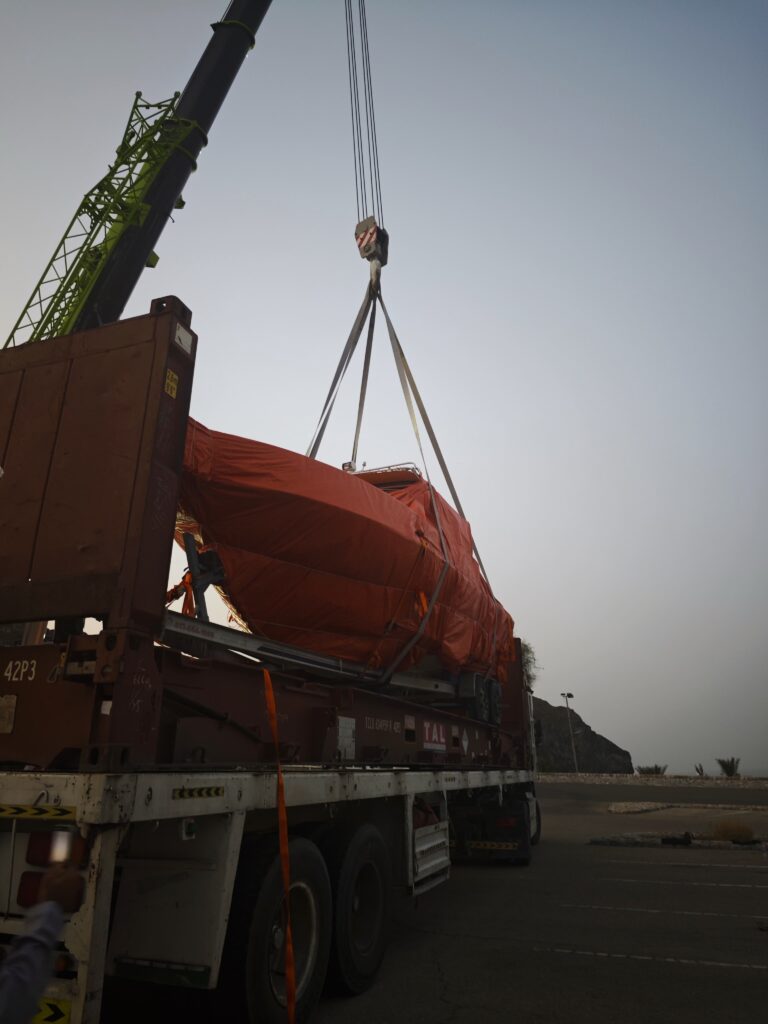
Oversized Cargo Transport Services
Navigating a colossal wind turbine blade down a busy city street is no small feat; it’s oversized cargo transport at its finest.
Oversized cargo transport involves the meticulous planning and coordination of transporting exceptionally large items across vast distances – a true testament to human ingenuity and engineering prowess.
Understanding Oversized Load Transport
Oversized load transport exemplifies the intricate orchestration required to move massive items efficiently. It demands impeccable planning.
Identifying the best routes, addressing potential obstacles, and ensuring public safety are vital.
Oversized load transport encompasses navigating various logistical challenges that arise from transporting enormous goods like prefabricated buildings, turbines, and industrial machinery.
Thorough coordination with governmental bodies, acquisition of necessary permits, and employment of specialized equipment ensure that such transportation projects are executed smoothly. In this paradigm of transportation excellence, there exists an “art” of overcoming these monumental challenges.
Types of Oversized Cargo
Oversized cargo encompasses a variety of extraordinary dimensions, including but not limited to prefabricated structures, massive industrial machinery, and colossal turbines. Vehicles, yachts, and expansive bridge components also fall under this category, each requiring meticulous planning for their transport.
Oversized Cargo vs. Gauge Cargo Transport
Understanding the dichotomy between oversized cargo and gauge cargo transport is essential for logistical efficiency. Oversized cargo pertains to items that exceed size norms, while gauge cargo remains within standard dimensions.
Oversized cargo often requires specialized vehicles and permits, whereas gauge cargo can utilize conventional transportation methods.
Managing oversized cargo necessitates detailed coordination with relevant authorities and acquisition of permits to ensure compliance and safety. In contrast, gauge cargo transport benefits from streamlined procedures and generally faces fewer regulatory barriers.
Despite the differences, both types share a common goal: achieving timely and secure delivery. By leveraging advanced planning and utilizing the appropriate resources, both oversized and gauge cargo can be transported with unparalleled success.
How to Ship Heavy Loads?
Shipping heavy loads necessitates exquisite logistical coordination, a spectrum of specialized transportation options, and meticulous safety measures. Foremost, comprehending the load’s dimensions and weight is paramount, followed by selecting a meticulously engineered transport vehicle tailored to the cargo’s unique specifications. Additionally, securing the appropriate permits and coordinating with regulatory bodies fortifies adherence to legal requirements. Meticulous route planning, especially considering infrastructural limitations and environmental factors, ensures seamless navigation and mitigates potential risks. With diligent preparation and strategic execution, shipping heavy loads becomes a highly achievable feat, exemplifying prowess in the domain of oversized cargo transport.
Challenges of Transporting Oversized Loads
Transporting oversized loads presents significant challenges.
One of the primary challenges involves route selection. Not all roads are equipped to handle the unique specifications of oversized cargo, necessitating a thorough assessment of bridges, overpasses, and road widths to ensure safe passage. Moreover, securing the required permits from various jurisdictions can be a meticulous, time-consuming task.
Moreover, weather conditions can significantly impact schedules.
The need for specialized equipment and skilled personnel is paramount – not every transportation company possesses the capacity to manage such intricate operations to the highest standard. This requires leveraging state-of-the-art technology and reliable, well-trained teams.
Despite these challenges, advances in logistics and transportation technology in recent years have been exemplary. Companies are increasingly equipped with innovative tools and best practices to surmount these obstacles, assuring that oversized cargo transport remains a robust and reliable enterprise.
What Affects the Cost of Transporting Oversized Loads?
Size and weight are significant factors.
The larger and heavier the load, the more it costs to transport. This is because bigger and heavier loads require specialized equipment and more robust vehicles, which are often more expensive to operate and maintain. Additionally, the scale of the load can necessitate more extensive route planning and additional legal permits, which further drive up costs.
Distance also plays a crucial role.
The longer the distance, the higher the overall cost. Fuel, driver wages, and vehicle wear and tear are all directly proportional to the distance traveled, making it a critical factor in cost estimation.
Specialized equipment is another determining factor – as not every load can be transported using generic vehicles. The need for cranes, flatbeds, and other custom machinery can significantly influence price.
Lastly, regulatory compliance and escorts are pivotal. Some jurisdictions mandate police or private escorts for oversized loads, which add to logistical expenses. In 2023, new regulations may also introduce further complexities that necessitate additional investment, ensuring alignment with evolving standards.
Types of Loads That Require Special Handling
Oversized cargo transport often includes a diverse array of materials that demand extraordinary care. These can range from industrial machinery, modular homes, and wind-turbine blades, to massive infrastructure components such as bridges and pre-fabricated buildings.
Such specialized loads necessitate unique handling protocols and transportation strategies to ensure safe delivery. The complexity and scale of these items often require meticulously designed plans and custom-built conveyance solutions.
Essential Steps to Ship Large Freight
Shipping large freight requires meticulous planning, beginning with a comprehensive needs assessment of your oversized cargo transport requirements. Understanding the scale and nature of your cargo is the initial step to ensure a seamless process.
Collaboration with experienced logistics partners is crucial for effective execution.
After the needs assessment, develop a detailed transportation blueprint that includes route planning, permits, and regulatory compliance measures. Ensure all key stakeholders adhere to this well-crafted plan.
Constant communication and real-time tracking can greatly enhance efficiency. Staying connected allows for prompt issue resolution, ensuring the cargo reaches its destination without unnecessary delays. Emphasize safety, innovation, and reliability throughout the entire transport process for an inspiring success story.
Navigating the Challenges of Big Load Logistics
Transporting oversized cargo requires intricate coordination of numerous logistical elements to guarantee a smooth journey from origin to destination. This complexity can be daunting, but it’s surmountable.
Challenges such as route restrictions, permit acquisition, and safety protocols are pivotal.
Careful pre-planning can mitigate many obstacles. Equip your team with a comprehensive understanding of the regulatory landscape and regional infrastructure to ensure an adept handling of sizable shipments.
Integrating technological solutions is paramount to streamline operations. Implement advanced tracking systems and real-time data analytics to receive updates and make informed adjustments. In doing so, you enhance not only the efficiency and reliability of your transport but also reinforce a culture of excellence.
Cost Factors and Budgeting for Large-Scale Shipments
Determining the cost of oversized cargo transport involves a multifaceted approach, reflecting various influencing elements.
- Size and Weight: Larger and heavier cargo typically incur higher transport fees.
- Distance: Longer transport distances increase fuel costs and labor charges.
- Route Complexity: Challenging routes with geographical or infrastructural restrictions may require specialized equipment or permits.
- Permits and Documentation: Obtaining necessary legal clearances can add to overall expenses.
- Specialized Handling: Unique cargo often necessitates bespoke handling solutions, impacting costs.
- Insurance: Comprehensive coverage for high-value or fragile shipments is crucial and can be a significant expense.
- Seasonality: Transport costs may vary with seasonal demand fluctuations and weather conditions.
Understanding these factors will equip you with the insight needed for effective budgeting.
Strategically planning around these variables can optimize your transport expenditure, ensuring cost-efficiency.
Navigating the Challenges of Big Load Logistics
Oversized cargo transport, a domain of extraordinary intricacies, requires sharp acumen and unwavering determination. Surpassing conventional shipment parameters, it demands meticulous planning and specialized equipment. Transporting colossal loads across diverse terrains and jurisdictions necessitates a robust framework of industry expertise, regulatory compliance, and logistical acumen, transforming potential hurdles into seamless milestones, and ensuring the successful delivery of your invaluable cargo to its destination with precision and care.
Key Considerations for Moving Large Loads
Securing the necessary permits for oversized cargo transport demands extensive foresight, precise documentation, and a keen understanding of local, state, and international regulations, ensuring smooth transit across all jurisdictions.
Careful route planning with attention to bridge clearances, road widths, and turnaround capabilities is paramount for navigating safely and efficiently.
Types of Heavy Haul Cargo Explained
Heavy haul cargo encompasses a range of large, weighty items that exceed standard shipping norms but are crucial for various industries and projects.
Firstly, construction equipment often requires heavy haul transport. This includes bulldozers, cranes, excavators, and other machinery essential for building and infrastructure development. These substantial pieces of equipment are integral to efficient project timelines.
Additionally, energy sector components such as wind turbine blades and power transformers necessitate specialized heavy hauling. Their immense size and weight demand sophisticated transport solutions to ensure safe delivery to sites where energy solutions are being constructed and deployed.
Furthermore, prefabricated structures and large industrial units often fall under the heavy haul category. Transporting these items involves precise logistical coordination due to their massive dimensions and the intricate nature of handling and securing them during transit. These seamlessly orchestrated transport efforts are the backbone of many successful large-scale projects.
Essential Steps for Planning Your Shipment
Effective planning is the bedrock of successful oversized cargo transport.
Start by understanding the exact dimensions and weight of your cargo. It’s paramount to know the specific requirements of your shipment, as these will impact the choice of transport equipment, permits needed, and route selection. Additionally, familiarizing yourself with the regulations of the regions your cargo will traverse is essential to avoid unforeseen complications.
Engage a specialized logistics provider.
Their expertise in oversized cargo transport will be instrumental in maneuvering the complex landscape. They can assist with securing necessary permits, liaising with local authorities, and ensuring that all safety protocols are adhered to. Enlist their help early in the planning process to streamline operations.
Consider potential obstacles and challenges.
Every route may present unique hurdles, from low bridges to tight turns. Conduct a thorough route survey to identify and plan around these challenges, ensuring that your cargo’s journey is as smooth as possible.
Finally, establish a communication plan that includes regular updates and contingency planning. By anticipating potential issues and maintaining open lines of communication, you can swiftly adapt to changes, ensuring the seamless, on-time delivery of your oversized cargo.
Overcoming Common Challenges in Heavy Hauling
Conquering the complexities of oversized cargo transport demands foresight, precision, and a profound understanding of the myriad challenges involved. These formidable obstacles, however, are not insurmountable with the right strategies.
Collaborate with experienced professionals.
Their vast knowledge and seasoned expertise will guide you through the intricate logistics of heavy hauling. Such collaboration is pivotal to navigating regulatory, technical, and operational barriers.
Leverage advanced technology for route planning.
Innovative tools provide real-time data and predictive analysis, essential for circumventing potential route impediments. These technologies enhance efficiency by preempting disruptions.
Strengthen your contingency plans.
Anticipating unexpected hurdles and devising strategic solutions can mitigate risks significantly. Well-articulated contingency plans ensure resilience and continuity in operations.
Invest in comprehensive training for your team.
A well-prepared team can adeptly handle the dynamic aspects of heavy hauling, ensuring safety and compliance. Commitment to ongoing education fosters an environment of continuous improvement.
By embracing these measures, you not only overcome challenges but also set a standard of excellence in oversized cargo transport. Your success story can inspire and drive industry advancements.
When it comes to securing legal compliance, obtaining special permits is a fundamental step. Depending on the size and weight of the cargo, various jurisdictions may require different types of permits. These special permits need to be acquired well in advance to prevent any delays or legal issues. They are critical in ensuring that the cargo meets all regulatory guidelines, thus avoiding penalties and guarantees the smooth execution of the transport operations.
Cost Factors to Consider for Transporting Big Freight
Transporting oversized cargo involves intricate cost-analysis that requires meticulous attention to detail, from permitting and route surveys to specialized equipment.
It is crucial to understand that expenses such as fuel consumption, labor costs, and insurance premiums (including potential additional insurances) significantly impact the overall budget, making it essential to accurately forecast these outlays.
The terms “valuable” and “impactful” best describe understanding the ‘hidden’ cost components to ensure informed decision-making.
Essential Equipment for Heavy Haulage
The foundation of effective oversized cargo transport lies in the tools used.
Central to the operation are robust tractors and trailers, each designed to handle monumental weights and dimensions. An essential first investment.
In addition, hydraulic jacks, cranes, and forklifts create a synergy that facilitates seamless loading and unloading operations, ensuring minimal disruptions.
Equipped with GPS and communication devices, the fleet remains on course and connected, elevating operational efficiency and punctuality.
Safety gear, such as harnesses and warning systems, ensures that every task is conducted with utmost care and diligence.
Safety Measures You Can’t Ignore
Ensuring safety during oversized cargo transport is paramount, driven by high stakes and intricacies. As operators navigate multifaceted logistics, every measure taken is integral to mission success.
Firstly, securing cargo with appropriate restraints is non-negotiable. This avoids load shifts.
Regular vehicle inspections are mandatory to certify that all transport equipment functions optimally, guaranteeing the utmost reliability.
Furthermore, collaborating closely with experienced pilots and escort vehicles enhances road safety, as these teams scout and mitigate impending risks, prevent accidents, and ensure compliance with regulations. Adopting the philosophy of “safety first” is indispensable for trust and success in this domain.
Understanding Permits and Legalities
Navigating the realm of oversized cargo transport mandates comprehensive knowledge of permits and legal requirements.
- Research Regulatory Requirements: Familiarize yourself with federal, state, and local regulations to ensure compliance.
- Secure Necessary Permits: Obtain all required permits well in advance to avoid project delays.
- Route Planning: Plan your route meticulously to ensure it meets regulatory standards and accommodates large cargo.
- Engage Legal Experts: Consult with legal professionals specializing in transportation laws to remain compliant.
- Monitor Changes: Stay updated on regulatory changes that could impact future transports.
Adhering to these guidelines ensures seamless operations and legal compliance.
Proactively addressing legalities establishes a foundation of trust and reliability in oversized cargo transport.
Factors Influencing Transport Costs
The expense of oversized cargo transport depends on several factors.
Route distance plays a critical role in cost determination. Longer routes usually incur higher expenses due to increased fuel consumption, potential tolls, and wear on transport vehicles. Additionally, the route itself can dictate specific permits or require specialized handling procedures, further impacting costs.
Cargo dimensions significantly influence overall expenses.
Larger or irregularly shaped cargo necessitates customized solutions. This might involve specialized equipment or even adjustments in infrastructure to facilitate smooth transit, inevitably raising transportation costs.
The mode of transport chosen is crucial too – be it by road, rail, air, or sea – each has unique cost structures influenced by the cargo’s size and weight.
Time frames and urgency of delivery further affect costs. Expedited services naturally come at a premium, necessitating precise coordination and potentially additional permits. Ensuring optimal delivery conditions while adhering to stringent timelines accentuates the importance of a meticulously strategized approach in oversized cargo transport.
Final Words
Oversized cargo transport is both an art and a science, demanding meticulous planning and strategic foresight.
With a clear understanding of the myriad challenges presented by irregular dimensions, weight considerations, and unique route requirements, one can expertly navigate this complex field. Embrace the intricacies of these logistical endeavors, acknowledging that each transport project offers an opportunity to refine and elevate operational excellence.
Remarkably, the success of oversized cargo transport hinges on collaboration. By fostering a network of skilled professionals, leveraging technological advancements, and maintaining open communication channels, logistics teams can achieve outstanding results even under the most demanding conditions.
Ultimately, embracing the complexities of oversized cargo transport not only delivers physical goods but also builds a reputation for reliability and innovation. Through careful planning, expertise, and strategic partnerships, the daunting task of moving oversized cargo transforms into a testament to human ingenuity and determination.


